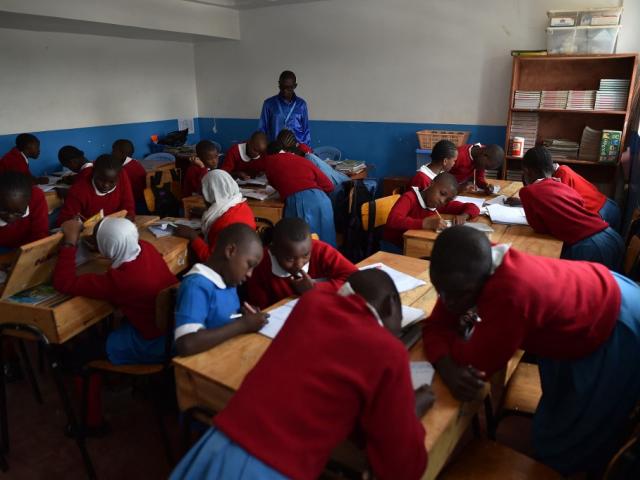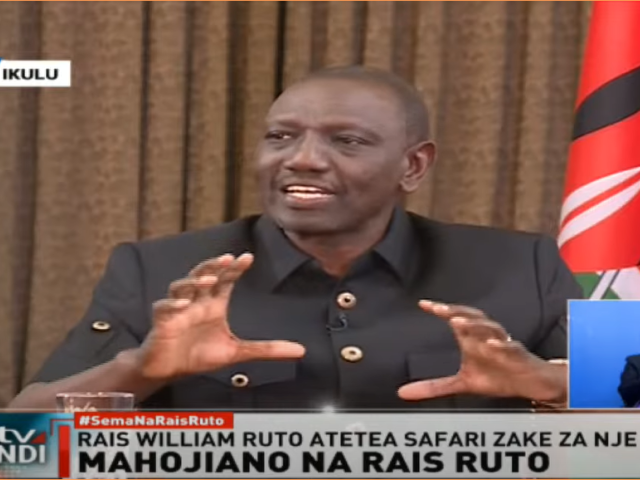-
The publications were correct on one count – that 60% of people in Africa are younger than 25.
-
The weakening of the shilling under president William Ruto was understated – it’s higher – and claims about the growth of the country’s public debt and debt-to-GDP ratio were outright incorrect.
-
The media also got Kenya’s population figures wrong, as the country had a projected population of 51.5 million in 2023, not 40 million, with 35% – not 45% – younger than 15.
Kenya’s debt burden remains an issue of national debate, as picked up by the artificial intelligence (AI) tool Africa Check uses to monitor public debate.
On 17 January 2024 the International Monetary Fund approved the release of US$941.2 million to Kenya, as the country's treasury burns the midnight oil to get public debt under control.
The IMF has even set up a page of “frequently asked questions” about its loans to Kenya.
A rapidly depreciating currency has added to the economic woes, creating a political headache for president William Ruto, who took office in September 2022.
There is also pressure on the government to improve the livelihoods of young Kenyans, sparking debate about the size of the population.
As Ruto’s government urges patience, we identified eight claims related to the Kenyan economy and checked them for accuracy.
On 16 January 2024, Kenya’s Star newspaper published an article on the country’s debt burden, claiming that in the decade between 2013 and 2023 “the total public debt grew almost five times to $69 billion (KSh11.1 trillion)”.
Africa Check contacted the author, who shared a presentation by Stears, a Nigerian data and business intelligence company, which was publicly released on 4 January.
The Stears report noted that " between 2013 and 2023, the total public debt grew 5x [five times] to $69 billion …”. The report says the final figure was converted using the average 2013 exchange rate of “KSh139.8 to the dollar”.
However, the company did not provide any information on the source of the underlying data.
Analysts have previously told Africa Check that Kenya’s national treasury publishes annual debt data according to the financial year, which runs from 1 July to 30 June.
The country’s central bank further publishes monthly debt data. This showed that public debt stood at KSh1.79 trillion in December 2012 and KSh1.81 trillion in January 2013.
The most recent monthly report put the total public debt at KSh10.6 trillion, as at 30 September 2023. This was also the figure recorded by the treasury in its most recent quarterly economic report, published in November 2023.
The increase from KSh1.79 trillion at the end of 2012 (and KSh1.8 trillion at the beginning of 2013) to KSh10.6 trillion at the end of September 2023, the latest month for which the Star has compiled data, is 5.9 times.
The debt did increase more than fivefold in Kenyan shilling terms. But in dollar terms, which the claim has considered, the increase is 3.5 times.
Further, as of September 2023, external debt accounted for 53.5% of Kenya’s gross public debt.
But there’s little doubt that debt has increased. On 17 January 2024, the IMF published a report estimating Kenya’s debt-to-gross domestic product (GDP) ratio at 67.9% in 2022, with projections of 73.2% in 2023 and 73.3% in 2024. – Makinia Juma
Gross domestic product (GDP) measures the size of a country’s economy and refers to the market value of all goods and services produced during a given period, usually a year.
The debt-to-GDP ratio measures the level of debt relative to the size of the economy, Noah Wamalwa of the Institute of Economic Affairs - Kenya, a public policy thinktank, told Africa Check.
If the ratio is low, it means that the amount of debt is relatively small compared to the size of the economy, and therefore the country is able to repay the debt without much difficulty, he said.
Kenya’s treasury publishes annual debt management reports with debt-to-GDP data.
In June 2012, the debt-to-GDP ratio was 40.7%, and 42.1% in June 2013, according to the 2015/16 debt report. It increased to 68.1% in June 2021 and was provisionally estimated at 67.3% in June 2022.
The most recent monthly debt data showed the debt ratio at 70.8% of GDP in June 2023. In a January 2024 report, the IMF projected the ratio at 73.2% in 2023. – Makinia Juma
We found this claim in a story published by Kenyan digital news platform Tuko.
“The shilling has lost over 27% of its value since president William Ruto took over power,” read the caption to a photo of the Kenyan leader.
Ruto was sworn in on 13 September 2022. According to central bank data, the shilling traded at KSh120.37 on 14 September 2022, a day after his inauguration.
On 16 January 2024, when the Tuko article was published, the Kenyan currency was at KSh160.18 to the dollar.
The difference is KSh39.81 or 33.1%, significantly higher than in the claim. We therefore rate it as understated. (Note: See what our ratings mean.) –Dancan Bwire.
The Kenyan shilling has been steadily losing value. What does this mean?
Noah Wamalwa of the Institute of Economic Affairs Kenya, a public policy thinktank in Nairobi, said the depreciation meant that “you are using more shillings to buy a dollar than you were a year ago”.
Is that good or bad? “It depends on the context,” Wamalwa told Africa Check.
“It is usually a good thing if the country is in a position to benefit from the weak shilling in terms of increased exports. But when a country is also in a situation where it has to meet its debt obligations, which are huge, especially on the external side, such as at this time, it is not a good thing,” he said.
The Kenyan national treasury said that as of June 2023, just over two-thirds (67.2%) of Kenya’s external debt was in US dollars, while another 21.3% was in euros.
At that time, external debt accounted for 52.9% of total debt. In September 2023, the most recent data available, external debt accounted for 53.5% of the total.
The country has been under pressure to pay its foreign loans. International rating agencies Fitch and Moodys have downgraded Kenya, citing risks associated with the weakening shilling. Economic predictions show that Kenya is “likely to face a debt repayment crunch in 2024” as foreign debt matures.
Dr Joseph Muniu, the chair of the department of applied economics at Nairobi’s Kenyatta University, said Kenyans would now be forced to dig deeper into their pockets to import as the purchasing power of the shilling had fallen.
Exporters were benefiting, he told Africa Check. “If you used to export something and you were being paid one dollar, in the past it could attract KSh120. Right now it will fetch you KSh160,” he told Africa Check.
Muniu said that when a country imports more than it exports, it loses money. The latest data released on 29 December 2023 shows that Kenya's imports totalled KSh648.6 billion and exports KSh269.4 billion in the third quarter (July-September) of the year.
“In the short run, the country suffers, but in the long run, more exporters will come on board because of the good returns, which is a good thing.”
This claim comes from a guest blog on Nation.Africa, the website of Kenya's largest media house.
The Kenya National Bureau of Statistics publishes annual population estimates from a census conducted every ten years. The last census took place in 2019 and put Kenya's population at 47.6 million.
The latest population estimates, published in the bureau’s flagship annual economic survey for 2023, show that Kenya had a projected population of 51.5 million in 2023.
Kenya’s population was 40 million in 2012, more than a decade ago. The claim is incorrect. – Dancan Bwire
The Nation.Africa blog also claimed that 45% of Kenya’s population was under the age of 15. The author cited the national statistics bureau as the source.
The bureau’s 2019 census report showed that 18.5 million people were under the age of 15. This was 38.98% of the population at the time.
In the latest estimates published in November 2022, the under-15 population was expected to fall to 18.37 million or 35.7% of the total population of 51.5 million in 2023.
In 2024, with a projected total population of 52.4 million, the under-15 population is expected to be 18.45 million or 35.2% of the total population.
We rate the claim as incorrect. – Dancan Bwire
The 2019 census report and the 2023 analytical report on population dynamics showed that 9.7 million out of 47.6 million people, or 20.4% of the population, were aged between 15 and 24.
The most recent estimates, published in November 2022, projected the population aged 15 to 24 to be 10.8 million out of 51.5 million, or 20.9% of the total population in 2023.
In 2024, this age group is projected to reach 10.9 million, or 20.8% of a total population of 52.4 million. – Dancan Bwire
The Nation.Africa blog also claimed that 60% of Africa’s population is under the age of 25.
Data on this can be found in the World Population Prospects 2022, as United Nations population official Dr Thomas Spoorenberg has previously told Africa Check.
The most recent data covers the year 2021. It showed that out of 1.39 billion people in Africa, 829.4 million are under the age of 25. This is 59.7%. (Editor’s note: A downloadable Excel file is available here.)
We also checked this claim when the US ambassador to Kenya Margaret “Meg” Whitman made it in 2023 and found it to be accurate. – Grace Gichuhi
The AI tool matched this claim to an earlier one made by president Ruto three times, including on New Year’s Eve 2023.
In verifying Ruto’s claim, we asked the World Bank for data, but the bank referred us back to his office. We rated the claim as unproven pending a response.
According to his bio, the author of the Nation.Africa article works for the “Presidential Communication Service”. We have contacted him for the source and will update this report when we hear back.
Of the 217 countries for which World Bank growth rates are available, at least 195 had data up to 2022, the most recent year for which annual data is available. Kenya was ranked 75th, with a GDP growth rate of 4.8% in 2022.
The latest data from the International Monetary Fund includes estimates of GDP growth data for 195 countries. The data also puts Kenya’s growth rate for 2022 at 4.8%. This placed the country 81st, tied with Albania, Austria, Bhutan and Liberia. The growth rate for 2023 is estimated at 5%, placing Kenya 34th, alongside China, Indonesia and Djibouti. (Editor’s note: A downloadable Excel file is available here.)
When countries with similar growth rates are ranked together, Kenya placed 44th in 2022 and 21st in 2023. (See our working here).
However, it is important to note that the 2023 numbers are projections. The 29th place claim therefore remains unproven, as we have yet to see the World Bank data cited by the Kenyan presidency. – Grace Gichuhi








Add new comment